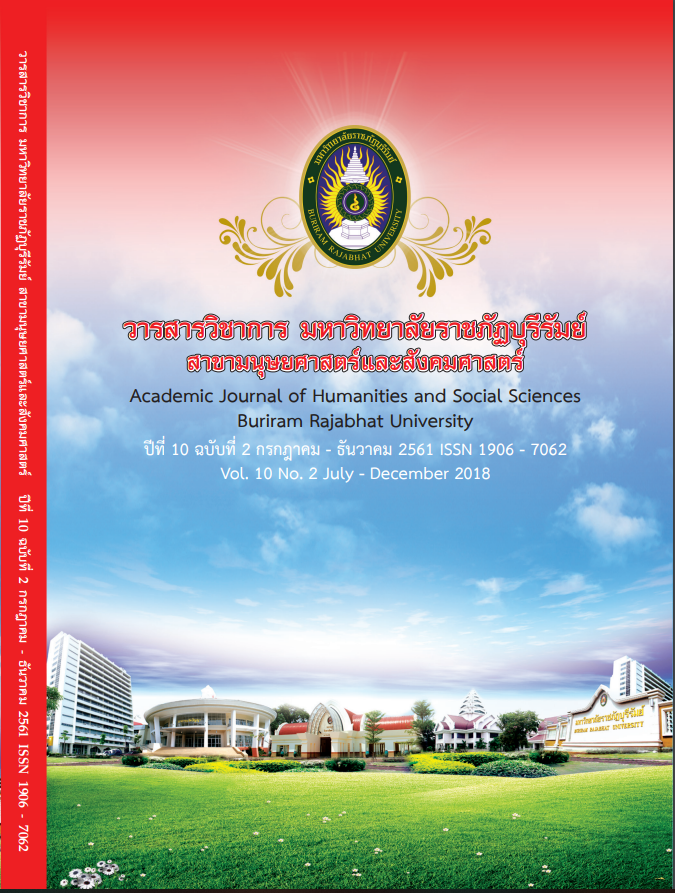Model of Formative Assessment
Main Article Content
Abstract
A major component of formative assessment practice is the collection and
aggregation of evidence of student learning. Formative assessment is a powerful
educational tool that has the potential to raise student or a positive effect on
achievement if used appropriately in the classroom. This article in promoting model
formative assessment. For guideline increate teacher 21st century assessment skill.
Such Black and Wiliam model, Torrance and Pryor model, Cowie and Bell model,
and Ruiz-Primo and Furtak model
Article Details
Section
บทความวิชาการ (Academic Paper)
- ต้นฉบับที่ได้รับการตีพิมพ์ในวารสารวิชาการ มหาวิทยาลัยราชภัฏบุรีรัมย์ สาขามนุษยศาสตร์และสังคมศาสตร์ ถือเป็นกรรมสิทธิ์ของมหาวิทยาลัยราชภัฏบุรีรัมย์ ห้ามนำข้อความทั้งหมดหรือบางส่วนไปพิมพ์ซ้ำเว้นเสียแต่ว่าจะได้รับอนุญาตจากมหาวิทยาลัยฯ เป็นลายลักษณ์อักษร
- เนื้อหาต้นฉบับที่ปรากฏในวารสารเป็นความรับผิดชอบของผู้เขียน ทั้งนี้ไม่รวมความผิดพลาด อันเกิดจากเทคนิคการพิมพ์
References
กระทรวงศึกษาธิการ. (2551). หลักสูตรแกนกลางการศึกษาขั้นพื้นฐาน พุทธศักราช 2551.
กรุงเทพฯ: โรงพิมพ์ชุมนุมสหกรณ์การเกษตรแห่งประเทศไทย.
ขจรศักดิ์ บัวระพันธ์. (2550). การประเมินผลระหว่างเรียน: แนวคิดและวิธีการ.
วารสารศึกษาศาสตร์ปริทัศน์, 22(2), 29-39.
เยาวดี รางชัยกุล วิบูลย์ศรี. (2550). การประเมินโครงการแนวคิดและแนวปฏิบัติ. พิมพ์ครั้งที่ 6.
กรุงเทพฯ: จุฬาลงกรณ์มหาวิทยาลัย.
วิจารณ์ พานิช. (2555). วิถีการเรียนรู้เพื่อศิษย์ในศตวรรษที่ 21. กรุงเทพฯ: มูลนิธิสดศรี-สฤษดิ์วงศ์.
ศิริชัย กาญจนวาสี. (2554). ทฤษฏีการประเมิน. (พิมพ์ครั้งที่ 8). กรุงเทพฯ: จุฬาลงกรณ์
มหาวิทยาลัย.
ส.วาสนา ประวาฬพฤกษ์. (2543). การประเมินการเรียนรู้. กรุงเทพฯ : มหาวิทยาลัศรีนครินทร
วิโรฒ.
สมนึก ภัททิยธนี. (2555). การวัดผลการศึกษา. (พิมพ์ครั้งที่ 8). กาฬสินธุ์: ประสานการพิมพ์.
สุรีพร อนุศาสนนันท์. (2558). การวัดและประเมินผลในชั้นเรียน. (พิมพ์ครั้งที่ 2) ชลบุรี: เก็ทกู๊ดครีเอชั่น.
Black, P., & Wiliam, D. (1998). Assessment and classroom learning. Assessment
in education, 5(1), 7-74.
Cowie, B., & Bell, B. (1999). A model of formative assessment in science education.
Assessment in Education: Principles, Policy & Practice, 6(1), 101.
Crocker, L. M., & Algina, J. (2006). Introduction to classical and modern test theory:
Holt, Rinehart, and Winston.
Croner, S. D. (2012). The effect of common formative assessments on teacher
efficacy (Order No. 3556187). Available from ProQuest Dissertations & Theses
Global. (1324104858). Retrieved from http://search.proquest.com/docview/
1324104858?accountid=44783.
Miller, M. D., Linn, R. L., & Gronlund, N. E. (2012). Measurement and Assessment
in Teaching Plus Myeducationlab with Pearson Etext -- Access Card Package
(11ed): ADDISON WESLEY Publishing Company Incorporated.
Ruiz-Primo, M. A., & Furtak, E. M. (2006). Informal formative assessment and scientific
inquiry: Exploring teachers' practices and student learning. Educational
Assessment, 11(3/4), 205-235.
Torrance, H., & Pryor, J. (1998). Investigating formative assessment: Teaching, learning,
and assessment in the classroom. Philadelphia, PA: Open University Press.
Torrance, H., & Pryor, J. (2001). Developing formative assessment in the classroom:
Using action research to explore and modify theory. British Education
Research Journal, 27(5), 615-631.
Wiliam, D. (2008). Improving learning in science using formative assessment.
In J. Coffey, R. Douglas & C. Stearns (Eds.), Assessing Science Learning:
Perspectives from Research and Practice. Arlington, VA: NSTA Press.
กรุงเทพฯ: โรงพิมพ์ชุมนุมสหกรณ์การเกษตรแห่งประเทศไทย.
ขจรศักดิ์ บัวระพันธ์. (2550). การประเมินผลระหว่างเรียน: แนวคิดและวิธีการ.
วารสารศึกษาศาสตร์ปริทัศน์, 22(2), 29-39.
เยาวดี รางชัยกุล วิบูลย์ศรี. (2550). การประเมินโครงการแนวคิดและแนวปฏิบัติ. พิมพ์ครั้งที่ 6.
กรุงเทพฯ: จุฬาลงกรณ์มหาวิทยาลัย.
วิจารณ์ พานิช. (2555). วิถีการเรียนรู้เพื่อศิษย์ในศตวรรษที่ 21. กรุงเทพฯ: มูลนิธิสดศรี-สฤษดิ์วงศ์.
ศิริชัย กาญจนวาสี. (2554). ทฤษฏีการประเมิน. (พิมพ์ครั้งที่ 8). กรุงเทพฯ: จุฬาลงกรณ์
มหาวิทยาลัย.
ส.วาสนา ประวาฬพฤกษ์. (2543). การประเมินการเรียนรู้. กรุงเทพฯ : มหาวิทยาลัศรีนครินทร
วิโรฒ.
สมนึก ภัททิยธนี. (2555). การวัดผลการศึกษา. (พิมพ์ครั้งที่ 8). กาฬสินธุ์: ประสานการพิมพ์.
สุรีพร อนุศาสนนันท์. (2558). การวัดและประเมินผลในชั้นเรียน. (พิมพ์ครั้งที่ 2) ชลบุรี: เก็ทกู๊ดครีเอชั่น.
Black, P., & Wiliam, D. (1998). Assessment and classroom learning. Assessment
in education, 5(1), 7-74.
Cowie, B., & Bell, B. (1999). A model of formative assessment in science education.
Assessment in Education: Principles, Policy & Practice, 6(1), 101.
Crocker, L. M., & Algina, J. (2006). Introduction to classical and modern test theory:
Holt, Rinehart, and Winston.
Croner, S. D. (2012). The effect of common formative assessments on teacher
efficacy (Order No. 3556187). Available from ProQuest Dissertations & Theses
Global. (1324104858). Retrieved from http://search.proquest.com/docview/
1324104858?accountid=44783.
Miller, M. D., Linn, R. L., & Gronlund, N. E. (2012). Measurement and Assessment
in Teaching Plus Myeducationlab with Pearson Etext -- Access Card Package
(11ed): ADDISON WESLEY Publishing Company Incorporated.
Ruiz-Primo, M. A., & Furtak, E. M. (2006). Informal formative assessment and scientific
inquiry: Exploring teachers' practices and student learning. Educational
Assessment, 11(3/4), 205-235.
Torrance, H., & Pryor, J. (1998). Investigating formative assessment: Teaching, learning,
and assessment in the classroom. Philadelphia, PA: Open University Press.
Torrance, H., & Pryor, J. (2001). Developing formative assessment in the classroom:
Using action research to explore and modify theory. British Education
Research Journal, 27(5), 615-631.
Wiliam, D. (2008). Improving learning in science using formative assessment.
In J. Coffey, R. Douglas & C. Stearns (Eds.), Assessing Science Learning:
Perspectives from Research and Practice. Arlington, VA: NSTA Press.

